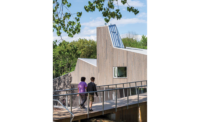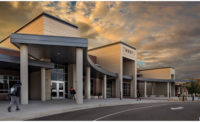Adlai E. Stevenson High School District 125, East Building Addition
Lincolnshire, Ill.
Best Project
Owner: Adlai E. Stevenson High School District 125
Lead Design Firm/Architect/Engineer: Wight & Co.
Construction Manager: Gilbane Building Co.
In addition to addressing growing enrollment at Adlai Stevenson High School, the project team for the $27-million east building addition also tackled ambitious sustainability goals. The 56,000-sq-ft, four-story building achieved net-zero energy, LEED Platinum and Living Architecture Performance Tool Certification Platinum certifications. The 100% electrically powered building is fueled by a 500-kW photovoltaic solar panel array on the roof of the addition and the adjacent school building. Excess power generated by the array is fed back to the electrical grid, making the building actually energy positive.
Other sustainable elements include green roofs, a recycled water filtration system and a two-story living wall that filters return air to the air handling units. More than 78% of construction waste generated during the project was recycled.
“The integration of all of the different technologies was challenging,” says Jeff Masters, senior project executive at Gilbane. “We’ve seen these elements on other projects, but not every system together. It was challenging from a budgeting perspective and how these systems can impact each other.”
The project also provided a greenhouse and garden area, where produce can be grown and used in the cafeteria.
Zoning requirements and net-zero requirements caused the design schedule to be compressed. With a firm completion date set for the start of the 2019-2020 school year, a fast-track schedule was established to complete foundations before winter. Early bid packages were developed for foundations, structural steel and load-bearing masonry. Those packages were awarded first, enabling a fall 2017 construction start. The remaining masonry and concrete work was included in later bid packages. Despite the split packages, there were no change orders for missed scope. The 21-month project was completed on budget and on time in July 2019.
As the construction manager at-risk, Gilbane was involved early in the project and engaged with the architect’s subconsultants, vendors, suppliers, local authorities and contractors to work through shop drawings and installation. BIM was used extensively throughout the project life cycle for visualizations, logistics planning, constructibility analysis, clash detection, improving speed and accuracy of estimates and optimizing construction sequence and integration into a functional facilities management tool. Gilbane also commissioned and integrated all new equipment into the school district’s existing computerized maintenance management system. Commissioning ensured that the photovoltaics produced the required output and the MEP system operated as efficiently as possible, which helped secure a $1-million grant for net-zero energy.








Post a comment to this article
Report Abusive Comment